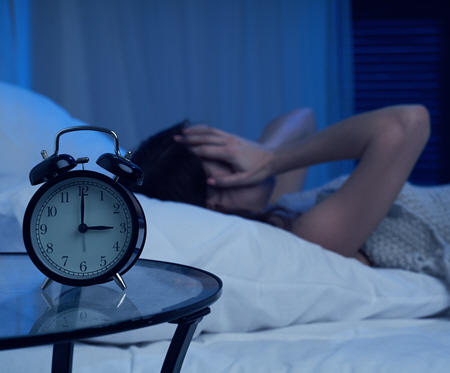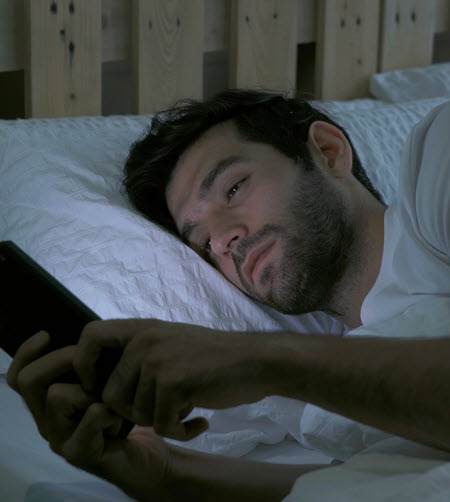 Had enough yet?
Had enough yet?
Enough of staring at the phone… just hoping you can fall asleep soon?
Enough of dragging yourself through another coffee-fueled day?
Enough of the tension all over your body?
How often have you thought, “If I fall asleep by 11:30, I should get seven hours tonight”?
You never get that seven hours, do you? No… you get what you can and stumble through the next day, foggy and frustrated.
Insomnia sucks!
Lack of sleep is killing you… literally.
“You can sleep when you die.”
That’s great advice if you don’t want to live very long!
Scientists can measure the degradation of our DNA by the length of our telomeres, and lack of sleep accelerates that degradation (which corresponds to aging and increased risk of mortality).
And when you consider other risk factors like sleep apnea, poor sleep can be deadly.
When you don’t get enough sleep, your brain can’t remove the toxins from life’s stressors – it builds up in your brain!
 You know sleep is important, but it’s not so simple for you.
You know sleep is important, but it’s not so simple for you.
If you have sleep struggles, you’ve probably taken a pill for it. There’s a lot of powerful marketing behind these pills, but there’s one problem:
It doesn’t give you the restful sleep that you really need.
Sleep medications can have adverse side effects, you may have withdrawal symptoms if you stop taking them, and they can have decreased effectiveness over time. It will not solve the root issue of insomnia and is more of a crutch.
That Lunesta blue butterfly? Yeah… it messes up your sleep architecture.
Let’s say you’re a “natural person,” so you take melatonin. Yes, melatonin is a natural hormone from the pineal gland, but exogenous use (introducing a hormone from outside the body) reduces your body’s production. So, long term, it can actually hamper your ability to fall asleep!
We’re here to offer you a long-term solution that works.
Cognitive-Behavioral Therapy – Insomnia (CBT-I) is the gold standard and preferred source of treatment for insomnia by the American Academy of Sleep Medicine.
 What happens in Cognitive-Behavioral Therapy for Insomnia or CBT-I?
What happens in Cognitive-Behavioral Therapy for Insomnia or CBT-I?
The process starts with a detailed interview about your sleep. From there, we will have you start logging your sleep and eventually move to restrict your sleep. Yes, you read that right! Paradoxically, with insomnia, one of the issues often is that an individual will spend far too long attempting to sleep.
Increasing sleep efficiency helps to reestablish healthy sleep patterns, which will help reset your sleep cycle. There are various sleep disorders, so the interview process will help clarify if this is insomnia or another disorder that should be approached differently.
Increasing your sleep efficiency…
One of the key measures is your sleep efficiency. Sleep efficiency measures the amount of time you are asleep while you are in bed. You can measure this by logging your sleep to the best of your memory, but with the advent of personal health trackers such as the Oura ring, Woop band, and Fitbits (the Oura ring and Woop band are much higher quality than the Fitbit/give more accurate data).
Personal health trackers make it easier to track your time in bed and time asleep. When you have those two measures, your sleep efficiency is the percentage of the time you are asleep divided by your time in bed (e.g., if you sleep six hours divided by eight hours in bed, your sleep efficiency is 75%). Sleep efficiency of less than 85% is often a sign of poor sleep quality. There are many reasons why this might be happening. Food and drink intake, caffeine or alcohol, and carrying too much worry are known to disrupt sleep patterns and behaviors.
Maintaining your ideal sleep architecture…
Using almost any drug or substance designed to help sleep can ironically throw off sleep architecture. Alcohol and Lunesta are sedatives that help you become more sedate BUT not sleep.
Generally, good sleep involves periods of deep sleep during the first half of the night and REM sleep in the second half of the night. Pharmacologically inducing sedation does not give you the sleep your body needs (and may hasten diseases like Alzheimer’s or dementia – Yikes!) Making lifestyle adjustments and addressing your sleep issues through CBT-I allows your body to help regulate and get back to normal sleep architecture. So you can experience genuine sleep (not sedation).
 Developing healthy habits…
Developing healthy habits…
This includes a wide range of behaviors. For example, it may include developing a bedtime and wind-down routine. It also may include such behavior changes as getting sunlight early in the morning (more on below), minimizing blue light in the evening, exercising (and doing this at least three hours before bed – ideally first thing in the morning), reducing caffeine and alcohol, etc.
Managing the stresses and worries of life is also a tremendous need in our nonstop culture.
Learning new ways of approaching thoughts and worries about sleep…
Worrying about sleep is very unhelpful! CBT-Insomnia helps with creating flexibility with your thoughts and beliefs about sleep. Andrew Huberman, Ph.D., said biology works with the law of averages. This is true with sleep. One bad night of sleep is not going to be harmful. What is harmful is the repeated pattern of poor sleep or lack of sleep.
Stressing each night as you go to bed will not help, and we can teach you the skills to relate more flexibly to your thoughts, feelings, and beliefs about sleep. Please reference the ACT page to learn more about this approach.
Tapping into your body’s natural rhythms…
One of the interesting things about sleep is that it is a 24-hour phenomenon. The decisions that you make throughout the day help you to sleep. For example, research supports getting significant amounts of light (10,000 lux or more) within an hour of waking to begin your body’s circadian rhythm.
Leading researchers like Matthew Walker, Ph.D., and Andrew Huberman, Ph.D., discuss the role of light exposure in the morning and minimizing blue light in the evening to help with sleep. Matthew Walker’s book – Why We Sleep, is a fantastic resource. The Huberman Lab podcast is an additional excellent source of information.
Using Neurofeedback for restoration…
One of the additional tools at our disposal is Neurofeedback to help your brain get back to restful sleep. Specifically, research has shown that rewarding Neurofeedback in the 12-15 Hz range while awake then shows increased sleep spindles (12-15 Hz activity). Increasing sleep spindles is a sign of improved sleep quality.
For those with chronic sleep problems, Neurofeedback can be a big assist in helping you get back to the restful sleep that you deserve. As mentioned in other pages about Neurofeedback, training your brain often can require 40-60 visits (or more). However, the benefits are lasting and can help you return to your “normal” self.
 This is about more than JUST sleep…
This is about more than JUST sleep…
One of the most evident truths I’ve learned over my career is that you will not be mentally or physically healthy if you don’t get adequate sleep. For example, one of the problems I consider when assessing if someone has ADHD is if the person has a significant sleep deficit. A brain with a significant sleep deficit will often appear very similar to an individual with ADHD (an under-aroused brain).
Lack of quality sleep affects everything, from our willpower and mood to basic cognitive abilities (and even factors such as the likelihood of developing diabetes or Alzheimer’s). When living in a world of poor sleep, everything is just harder!
Sleep is the key to good health, and you have options. It doesn’t have to be this way!
When you’re ready for better sleep and a brighter outlook on life, give us a call: (832) 831-0178.

